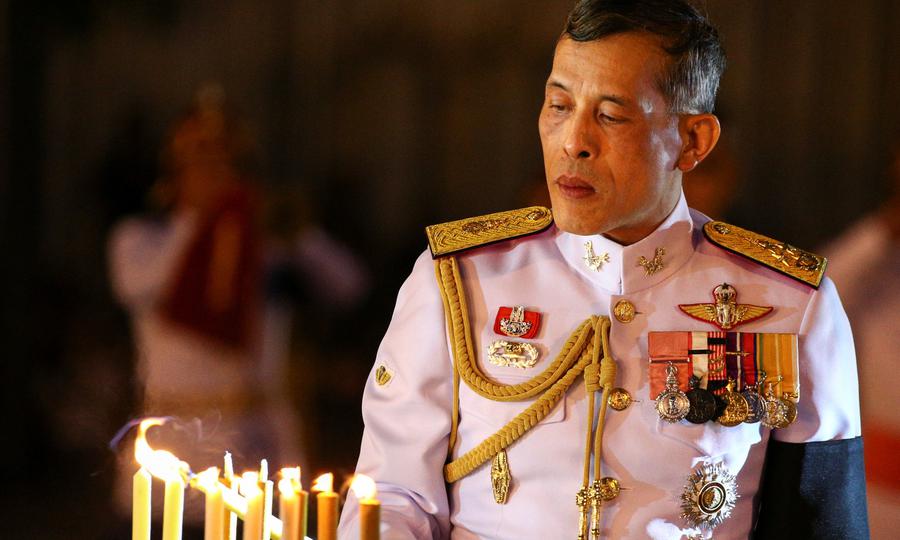[Analytics] How Thailand’s Rama X will be crowned

Thailand's Crown Prince Maha Vajiralongkorn. Photo: Twitter
Thai King Maha Vajiralongkorn will formally crown himself as monarch on Saturday (May 4) during an elaborate three-day coronation ceremony steeped in ancient Hindu and Buddhist rituals. The ceremonies will confirm him as Rama X, the 10th king in the centuries-old Chakri dynasty. Richard S. Ehrlich specially for the Asia Times.
Tens of thousands of people are expected to line Bangkok’s sweltering streets on Sunday (May 5) when Vajiralongkorn is carried on a palanquin followed by officials and a band during a four-mile, post-coronation procession from Bangkok’s Grand Palace.
The king will meet foreign diplomats and government officials on Monday (May 6), which has been declared a public holiday in the kingdom.
The military-led royalist government expects dissidents and politicians to show respect during the coronation’s May 4-6 ceremonies and silence their recriminations over the disputed results of last month’s elections.
In a May 1 surprise, Vajiralongkorn married his consort Suthida Tidjai, a general who commanded his bodyguards, and announced she was now Queen Suthida Vajiralongkorn na Ayudhya in Thailand’s constitutional monarchy.
Vajiralongkorn, 66, became king shortly after his father King Bhumibol Adulyadej died aged 88 on October 13, 2016.
Saturday’s coronation will present Vajiralongkorn as a “devaraja,” or divine king, able to protect Buddhism, a religion shared by an estimated 95% of the kingdom’s population.
If no major changes are made, here are the expected key events:
Vajiralongkorn will receive a name plate and seals made of gold brought in a solemn procession from Bangkok’s Temple of the Emerald Buddha.
The slab and seals are etched with Vajiralongkorn’s horoscope, royal name, and the name of Thailand’s Buddhist supreme patriarch, confirming the king has the influential clergy’s support.
Royal astrologers can use the slab’s astrological details to predict activities relating to Vajiralongkorn and his reign.
During Saturday’s coronation, he will undergo several washing and anointing rites which mix Hinduism’s Brahman and breakaway Buddhist purification traditions.
During one ritual, he will wear a white robe with his right shoulder bare and sit under a device shaped like a lotus that gently showers holy water onto him.
Ablution rites also allow the supreme patriarch, the chief court astrologer, and other officials to pour holy water onto his hands from blessed vases.
Vajiralongkorn will then change into regal attire including a heavy gold embroidered robe and ascend his Octagonal Throne to receive holy water presented by a Brahman priest and various officials.
The water was recently combined from auspicious sites in Thailand. In ancient India, royal Hindu rituals required consecrated water from India’s five holiest rivers, including the Ganges.
Brahmans will then present a royal nine-tiered umbrella to Vajiralongkorn, symbolizing his sovereignty.
Ancient kings often appeared with umbrellas instead of crowns. People believed the umbrellas housed wise spirits who advised any king sitting underneath and also guarded him.
Similar umbrellas protected shrines and other religious sites in ancient India, Java and Cambodia, and were later reinforced with wood until transforming into the world’s first pagodas.
Departing his Octagonal Throne, King Vajiralongkorn will then sit on a gilded figwood Noble Throne under his new umbrella.
A Brahman priest representing the Hindu god Shiva will declare the “Opening of Kailash’s portals,” inviting Shiva to enter the king’s body from Mount Kailash.
Mount Kailash in northwest Tibet is said to be Shiva’s mythical Mount Meru home.
The priest then will give the king exquisite royal regalia including the Sword of Victory, Royal Fan and Fly Whisk, Royal Staff, Royal Slippers, and Great Crown of Victory.
These pieces were created mostly from gold during the reign of King Rama I, who began the Chakri dynasty in 1782.
Unlike coronations elsewhere in which a monarch is crowned by a religious or other official, Vajiralongkorn will crown himself by lifting the headpiece with both hands and placing it upon his head.
The gem-encrusted crown weighs 16 pounds, rises in circular layers, peaks in an elongated spire and publicly appears only on coronation day.
At the crown’s top is a diamond purchased in India during the mid-19th century, capped by a tiny umbrella sheltering the glistening stone.
The crown’s circular shape symbolizes Mount Meru, indicating the king is enthroned at the center of Hinduism’s and Buddhism’s celestial universe.
He then will speak for the first time during the ceremony as a crowned monarch to gathered Brahman and Buddhist clergy and other witnesses.
He will recite the royal Oath of Allegiance invoking Buddhism’s Tenfold Practice of Ten Duties of Kingship.
These duties include generosity, moral behavior, self-sacrifice, honesty, gentleness, austerity, non-violence, tolerance, public welfare, and freedom from hatred.
While nearby Buddhist clergy chant blessings, troops outside the palace will fire a multi-gun salute.
More than 40,000 Buddhist temples throughout Thailand will then ring bells and gongs announcing and blessing the monarch.
He later will appear wearing his crown and sit on his elevated Golden Hibiscus Throne to greet invitees.
Afterwards, he will ride outdoors atop an opulent palanquin carried by more than 300 men in a procession to the Chapel Royal of the Emerald Buddha.
Brahman priests, speaking Sanskrit, Pali and Thai, will preside over many of Saturday’s coronation rituals to project a sacred status onto the monarch, who is presented as an incarnation of the Hindu god Vishnu.
Around 1200 B.C. in India, monarchs began using Hindu regalia to emphasize their godly powers.
In the first kingdom of Thailand – then known as Siam – during the 13th century Sukhothai era, Hindu regalia appeared in the coronation of King Dhammaraja I, who bore the title “maha” or “great,” which King “Maha” Vajiralongkorn has adopted.
Richard S Ehrlich is a Bangkok-based American correspondent reporting from Asia since 1978.